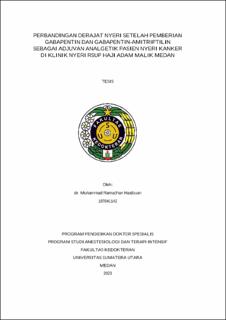| dc.description.abstract | Background: Chronic pain is one of the most implicated problems in cancer management, and often described as a neuropathic condition in which its management varies in number. Therefore, as a part of neuropathic pain, the necessity for an adjuvant analgesic intervention is unquestionably essential in palliative care. Several analgesic options have emerged for the last years from anticonvulsants (e.g., gabapentin) to tricyclic antidepressants (e.g., amitriptyline). Both possess high efficacious capability, but the effect of combining those agents remain questionable on whether it would prove to be superior than the single-agent approach.
Objectives: To compare the pain level after gabapentin and gabapentin-amitriptyline combination as an analgesic adjuvant treatment for cancer pain in Haji Adam Malik General Hospital.
Methods: This study is designed in randomized clinical trial with appropriate blinding method. Adult patients with cancer pain (Numeric Pain Rating Scale (NRS) 6-10) which hospitalized in our centre were included in this study, with the sample size target of 52 individuals. The statistical analysis was performed by using SPSS software.
Results: From 52 patients included, the majority is aged between 46-55 years old (32,3%) and male by gender (67,7%). The most common early symptoms reported in both treatment group were nausea (50-53%), with a decreasing trend toward the end of study. The administration of gabapentin or its regiment comparator may decrease the pain level as proven by NRS and pain detect scaling method up to 7 days post-treatment. However, there is no significant difference observed except for NRS improvement in day-3 to day-7 based on NRS scale (P<0,05), though the analgesic effect of both approaches were observable.
Conclusion: The single gabapentin or the combination between gabapentin and amitriptyline might reduce the pain scale of cancer pain, though the difference between both regiments were statistically insignificant. | en_US |


